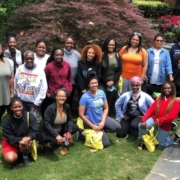Cannonballs Strike Whether We Realize It Or Not
BY ERIC CLAYTON | May 18, 2022
Editor’s Note: In honor of the 501st anniversary of the cannonball strike that changed the trajectory of St. Ignatius’ life, we’re sharing an excerpt from Eric Clayton’s new book, Cannonball Moments: Telling Your Story, Deepening Your Faith. From now until June 1, 2022, you can get 50% off your own copy when you use the promo code 5348. Click here to learn more and order.
The sound was incredible. It was like thirty-seven drumlines had suddenly been conjured out of thin air, all to play the exact same note again and again and again. Din. Din. Din. Din. Faster, slower, faster, slower. Then—a flash of light, all necks whipping heads in the same direction. Crash. And the cymbals played.
The storm had come quickly. We undergraduates were gathered under a wide tin roof, which was keeping the would-be auditorium dry. Well, dry enough.
We had just completed our walk through the neighborhood, a literal tour of poverty, and the dark, imposing storm clouds summed up our mood. These families lived next to a dump site in the shadow of Manilla, the Philippines’s capital city.
We already knew that too many people throw away perfectly good items every day. What was new, though, was meeting the men, women, and children who eked out a living picking those cast-off items out of the garbage. So common was this work—so devastatingly essential to survival—that a vast array of tin homes had sprung up around the massive dump site, shelter for the workers and their families.
My nineteen-year-old eyes weren’t quite wide enough to take it all in. We were on an Ignatian “experiment,” a Jesuit-sponsored service trip tacked on to that year’s World Youth Day in Australia.
The experiments were meant to provide spiritual fodder for our ongoing reflection. The encounters we had and the faces that haunted our memories would be brought into our communal prayer. We would bring those stories back with us to the States, to our college campus, and do something with them.
What? That remained to be seen. Certainly nothing on a par with the need of the moment.
So the rain finally stopped, and we could hear one another again. The children started running about, tugging at our clothes, smiling in spite of it all. And I remember pulling out my water bottle—a battered thing, something I knew could be replaced whenever I deemed it necessary, refilled without a problem—and I squirted water at those dancing little kids. And they laughed and danced in and out of range as I splashed water, a sad and sorry encore to the storm that had just passed. I could feel the weight of the eyes of the residents of that little community hanging on me, hanging on the frivolousness with which I played with their kids.
I was so pleased with myself because it had been hard for me to connect with anyone during our few days in the Philippines, and the laughter and joy and fun that was so palpable in that moment made me feel that I’d done it; I’d arrived. My reason for coming to the Philippines had been realized.
It wasn’t until I was back in the States, months and months of air-conditioned dorm living later, that it dawned on me that those heavy eyes watching my watery antics were likely seeing in my actions an ignorant and wasteful use of water. Nothing fun, nothing frivolous, but a serious, life-and-death matter.

That moment in the Philippines was very much a cannonball moment. Or perhaps more precisely, my slow realization of what my presence in the Philippines represented was. As I continued my undergraduate career, participated in more service trips, and spent a postgraduate year in Bolivia, all these disparate scenes represented a string of metaphoric cannonball strikes.
And slowly I grappled with a hard truth: My time in these foreign places was helpful and formative to me, even if largely unhelpful and quickly forgotten by my hosts. What to make of such seemingly incompatible realities? The slow straightening out of my life wasn’t worth the cost of who knows how many other lives in the Philippines, Nicaragua, Bolivia, and more. But the trajectory that those experiences set my life on led me to a concern for justice and peace and reconciliation. That’s good, right?
That was a humbling, challenging truth to wrestle with. I have yet to arrive at any satisfying answers. I’m still sorting through the wreckage the cannonball has left behind.
As unclear as next steps may be, the steps that led me to the cannonball strike are more obvious. And it’s all about holy restlessness. Nothing in my calculation accounted for the real flesh-and-blood people at stake, though I had some vague sense of wanting to help. Nothing in those nineteen-year-old eyes saw the problematic nature of a white kid parachuting in to get a good look at poverty before airlifting out.
There was that little rumbling deep within urging me to go. The desires were ill-formed, incomplete, and misplaced, and yet the cannonball struck nonetheless, the damage done—for good and bad—and here I sit all these years later, wrestling with what was and what might still be. I think that’s not a bad outcome. Because surely, tied up with it all is my vocation, an increasingly less-foggy plane of existence on which I can spot new and unique ways to apply those skills I have to share with the world. I look at myself, my mistakes, and wonder if I can rectify them. If I can make sense of them, can’t I then do some good?
Desolation to consolation and back again, and yet that sense of restlessness can push us onward. We spend some time looking inward, yes, perhaps a bit too self-absorbed, until we see the wider world. We see how our own restless selves—incomplete and imperfect—might do some good for another person. That’s the story of my time in the Philippines and beyond.
And this is the kind of story a keen eye for Ignatian restlessness can pull out of others, too. That restlessness inevitably puts us within striking distance of God’s holy cannonball, and when we’re struck, out of that restlessness we can begin to piece together a new way of seeing ourselves and the world.










Thanks Eric. You have fired yet another cannonball. It appears to be effective.
One other thing.. the shooter was an exceptional well trained shot. He had practice. He just walked and shot calmly no hesitation. Like nothing out of ordinary. Not mass.. he walked shot turned shot etc. It needs to be told. Because very important parts are being left out and not right. Hugs all im done … muah